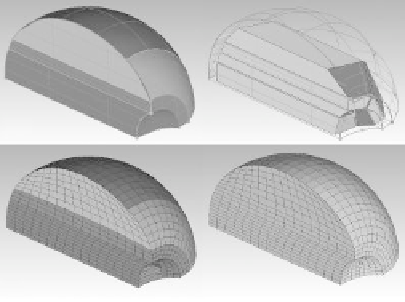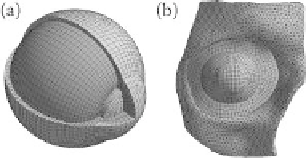Biomedical Engineering Reference
In-Depth Information
(a)
(b)
(c)
(d)
FIgure 21.5
(See color insert.)
Process of mesh generation for the vitreous model. (a) Surface creation.
(b) Block division. (c) Mesh preview. (d) Mesh generation.
FIgure 21.6
Finite element model of the human eye. (a) A hexahedron mesh was used for the cornea,
sclera, lens, ciliary body, zonules, retina, and aqueous and vitreous humors. (b) A tetrahedron mesh was used
for the complex structure of the orbit.
and fat, optic nerve and retina or sclera, and vitreous or aqueous and its neighboring tissues were
defined with bonded contacts, obligating them to move together at their respective interfaces.
21.2.4 m
odel
V
alidation
To validate the current eye model, three types of blunt projectile impacts (BB, foam, and baseball)
were undertaken to reproduce the simulations of the VT-WFU eye model by Stitzel et al. (2002).
Two different initial speeds were given to each type of projectile. Table 21.2 lists the details on the
loading information.
table 21.2
loading Information for the matched Simulations
Simulation
objects
mass (g)
diameter (mm)
velocity (m/s)
modulus (mPa)
S1
BB
0.375
4.50
56.0
200,000
S2
BB
0.375
4.50
92.0
200,000
SF1
Foam
0.077
6.35
10.0
2.208
SF2
Foam
0.077
6.35
30.0
2.208
SB1
Baseball
146.5
76.10
34.4
12
SB2
Baseball
146.5
76.10
41.2
12





Search WWH ::

Custom Search